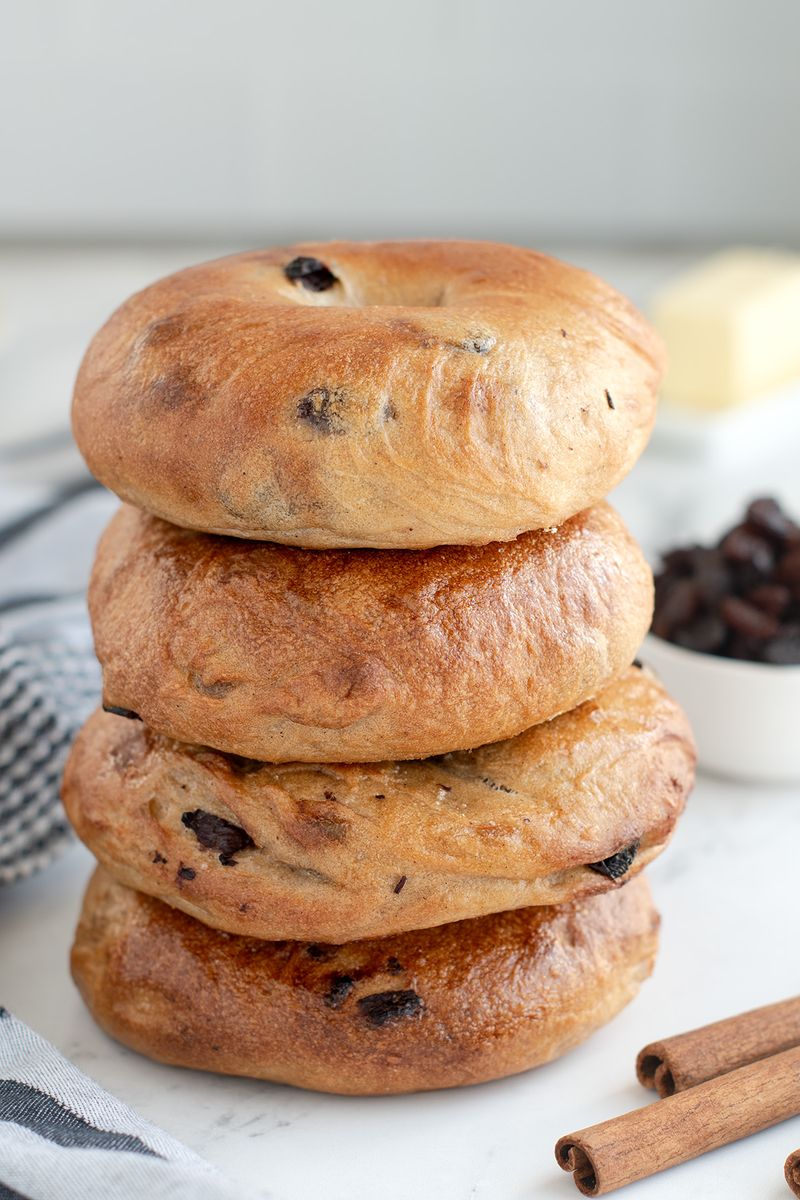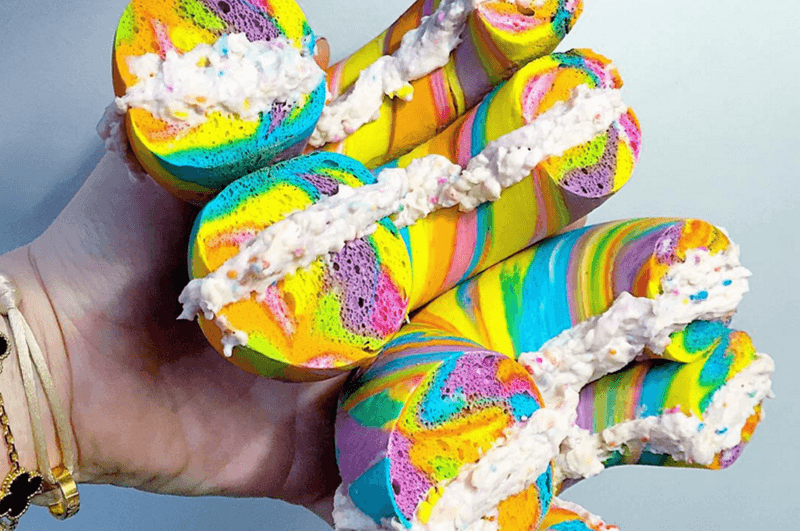Bagels—golden, chewy, and deeply satisfying—have earned a permanent place in the hearts (and breakfasts) of millions. Whether toasted to a perfect crunch or left pillowy-soft, these doughy delights are a go-to comfort food across the country. But not all bagels are created equal. In fact, some of the most popular and tempting flavors might be doing your diet—and your health—more harm than good.
Sure, it’s easy to get lured in by that glistening asiago crust or the sweet scent of cinnamon and raisins wafting from the toaster. We’ve all grabbed a colorful rainbow bagel or indulged in a chocolate-chip version thinking, “It’s just a bagel—how bad could it be?” The answer: surprisingly bad. Beneath the surface of these flavor-packed favorites lurk hidden sugars, excess sodium, unnecessary fats, and sometimes even artificial dyes. The worst part? Many of them offer little in the way of fiber, protein, or real satiety, which means you’ll be hungry again before lunchtime hits.
This list isn’t about ruining your love affair with bagels. It’s about helping you navigate the bagel shop menu with a sharper eye—and a smarter plate. By identifying the flavors that fall short nutritionally or lean too far into dessert territory, you’ll be better equipped to enjoy bagels that taste great and treat your body right.
So before you slather on the schmear and bite into your favorite breakfast staple, take a moment to find out which seven flavors dietitians, nutritionists, and food experts recommend leaving behind. Your taste buds may love them—but your health goals won’t. Let’s break down the bagels that might be better left on the shelf.
1. Asiago Cheese: The Saturated Fat Bomb
That golden, crusty cheese might make your mouth water, but your heart isn’t as thrilled. Asiago bagels contain roughly three times the saturated fat of a plain bagel, contributing to potential cholesterol issues over time.
The sodium content is another hidden danger – one Asiago bagel can contain up to 700mg of sodium, nearly a third of your daily recommended intake. Add cream cheese or sandwich fixings and you’re looking at a serious salt overload.
The calorie count typically exceeds 350 per bagel before any spreads, making this cheesy option one of the least nutritious ways to start your day.
2. Cinnamon-Raisin: Sugar Disguised as Breakfast
Behind that comforting aroma lies a sugar trap. The average cinnamon-raisin bagel contains 13-17 grams of sugar – that’s about 4 teaspoons – before you’ve even added any toppings!
Despite the presence of raisins, these bagels typically offer minimal fiber benefits. Most contain less than 2 grams of fiber, doing little to offset the blood sugar spike or keep you feeling full.
Many people compound the problem by adding sweet spreads like honey or flavored cream cheese, turning this seemingly innocent breakfast into a dessert-level sugar bomb that leaves you hungry again in no time.
3. Chocolate Chip: Dessert in Disguise
Fooling yourself into thinking this is breakfast? A chocolate chip bagel typically packs 15-20 grams of sugar and offers virtually no nutritional benefits beyond empty calories and a temporary energy boost.
The combination of refined flour and chocolate creates a double whammy for blood sugar levels. This leads to the classic spike-and-crash pattern that can leave you feeling sluggish by mid-morning.
Nutritionists point out that most chocolate chip bagels contain artificial flavors and preservatives alongside the chocolate, making them more processed than you might realize. You’d be better off having a proper breakfast and saving a real chocolate treat for dessert.
4. Rainbow Bagels: Artificial Everything
Instagram-worthy? Yes. Body-worthy? Not so much. Rainbow bagels get their vibrant colors from artificial dyes like Red 40, Yellow 5, and Blue 1 – synthetic chemicals that some research links to behavioral issues in children and potential health concerns.
Beyond the dyes, these colorful creations typically contain more sugar than plain varieties. The sweetness helps mask the chemical taste that would otherwise come through from all those artificial ingredients.
Many bakeries double down on the novelty by recommending funfetti cream cheese or other sugar-laden toppings, further reducing any nutritional value. Your body processes this bagel essentially the same as candy – just with more calories.
5. Plain White: The Refined Flour Problem
Sometimes the most basic option is still problematic. Plain white bagels are made from highly refined flour that’s been stripped of nearly all fiber, vitamins, and minerals during processing.
The glycemic impact is significant – white bagels can spike blood sugar similarly to eating pure table sugar. This triggers insulin production and potentially leads to energy crashes and increased hunger shortly after eating.
Size matters too – modern bagels have ballooned to about 4 ounces, more than double their original size from decades ago. This means you’re consuming approximately 300+ calories of nutritionally empty carbohydrates that provide little satiety or sustained energy.
6. Frozen Pre-Sliced Varieties: Preservative Paradise
Convenience comes at a nutritional cost. Brands like Lender’s add potassium sorbate, calcium propionate, and other preservatives to extend shelf life, ingredients you won’t find in fresh bakery options.
High fructose corn syrup frequently appears on the ingredient list, even in varieties that aren’t obviously sweet. This processed sweetener has been linked to increased risks of obesity and metabolic issues when consumed regularly.
The manufacturing process typically requires dough conditioners and texture enhancers that wouldn’t be necessary in authentic bagels. The result? A product that’s more chemistry experiment than actual food, lacking both nutrition and the satisfying texture of a true bagel.
7. Sweet Potato: Nutrition Illusion
Don’t let the vegetable name fool you. Most commercial sweet potato bagels contain minimal actual sweet potato – often just enough for color and marketing appeal. The orange hue frequently comes from food coloring rather than vegetable content.
Sugar content is surprisingly high, with many recipes adding brown sugar or honey to enhance the sweet potato flavor. This transforms what could be a healthier option into another sugar-heavy breakfast choice.
The fiber content rarely matches what you’d get from actually eating sweet potatoes. With typically less than 2 grams of fiber per bagel, these don’t deliver the digestive benefits you might expect from a vegetable-based food, making them just another starchy, sugary breakfast option.







Leave a comment